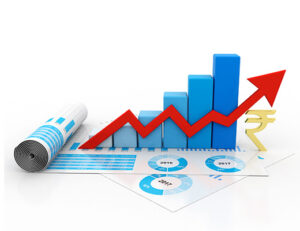The Covid-19 pandemic has hit the entire world hard and the economies of even the most developed countries can be seen struggling. The Indian economy has also been greatly affected by the covid outbreak. Its aftereffects have hindered the well-thought plan of India of becoming a $5 trillion economy by 2024-25.
In 2019, the Indian Prime Minister Narendra Modi envisioned making India an economy of $5 trillion by 2024-25 which would make India the third-largest economy in the world after the US and China. But according to the projections by IMF (International Monetary Fund), it will take longer than expected. In an optimistic scenario, it will take 3-4 years to achieve this aim and could be extended till 2029-2030.
The latest forecast of a 9.5% GDP (Gross Domestic Product) growth this fiscal year, followed by 8.5% growth next year, is more than what it has been in the last few years. But the growth has to accelerate more rapidly to reach the vision. A jump of Rs 375 lakh crore (68% increase) is required in the next 3 years to hit the target by 2025.

According to V Anantha Nageswaran (Chief Economic Advisor), India has already crossed the USD 3 trillion mark and moving forward with its vision. He said further, “If we continue to retain the path of 8-9 per cent real GDP, it would translate into 8 per cent dollar GDP growth. If we extrapolate that we should be at the USD 5 trillion by 2025-26 or 2026-27.” But IMF alludes that the goal of a $5 trillion economy is likely to be achieved by 2029 in the best-case scenario. The institution projected that by 2025, Indian GDP will be expected to reach 338 lakh crores.
The global and domestic price instability affects the demand and supply chain of India. The estimations of demand collapse were made by the experts but an unusual change was noticed on the supply side. According to the senior economists, the economy of India in the financial year 2022 depends on the stability and recovery of household incomes, informal sectors and the upcoming waves. There is a need to increase the public sector investments by the government to reverse the declining trend of overall investment. These initiatives are needed to lift the growth to 7% or above.
STEPS BY THE GOVERNMENT TO BOOST ECONOMIC GROWTH
The government is giving sectorial push by providing adequate funds and budget to provide the necessary support. Here are the few steps that were taken by the government to boost the economic growth:
- The manufacturing sector contributes a large share to the Indian economy. Pushing the manufacturing sector through budgets and ‘Make In India’ initiatives launched by the government help in increasing the GDP of India.
- The Indian government has set the roadmap to expand the exports by 2028 with merchandise exports worth $1 trillion and $700 billion in services.
- India’s digital economy has shown tremendous growth recently. Digital transactions fix the tax leakages resulting in an increase in tax revenue. The net tax revenue is expected to be 65% higher in April and November of the financial year 2022.
THE HOPE
The expectation of India becoming a $5 trillion economy can be achieved only in the following situations:
- If India consistently brings the USD INR exchange rate below the Rs 70 mark.
- If the exchange rate does not go below Rs 76 per $1, the target can be achieved by 2026.
- India can achieve its mark of $5 trillion if the GDP grows uniformly by more than 12%.
The situations like pandemic and the Ukraine-Russia conflict are the major factors behind obstructing India’s way to becoming a $5 trillion economy by 2024-25. However, the Chief Economic Advisor hinted toward its possibility stating that the GDP of India has crossed $3 trillion already. But it is highly unlikely to accomplish that mark. Whether India would become a $5 trillion economy depends on various parameters – Exchange Rate, GDP Growth, and Price Deflator-based Inflation among others.



